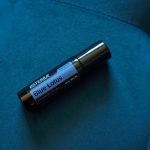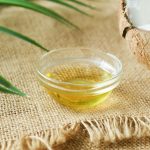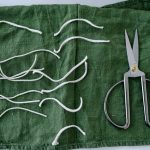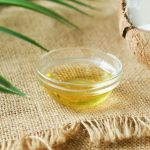To clean coconut oil off upholstery, start by blotting excess oil gently without rubbing, then sprinkle baking soda to absorb it and vacuum after 15 minutes. Use a mix of mild dish soap and warm water to blot the stain, or a diluted white vinegar solution if needed—always test first on a hidden spot. For stubborn stains, apply dish soap directly and repeat. Let the fabric air dry thoroughly to avoid water marks. Keep going to uncover detailed steps and expert tips for best results.
Table of Contents
Key Takeaways
- Immediately blot excess coconut oil with a dry cloth and sprinkle baking soda or cornstarch to absorb oil before vacuuming.
- Mix mild dish soap with warm water or a 1:1 white vinegar-water solution for gentle stain blotting, testing on hidden fabric first.
- Use a soft-bristled brush or clean cloth to gently lift the stain without rubbing, avoiding pushing oil deeper into upholstery fibers.
- For stubborn stains, apply dish soap directly, let sit 15 minutes, then blot; repeat or use a baking soda paste if needed.
- After cleaning, blot moisture, air dry away from sunlight, and consider professional cleaning for delicate fabrics or persistent greasy odors.
Understanding Coconut Oil Stains on Upholstery
Although coconut oil is popular for its many uses, it can quickly leave stubborn stains on your upholstery.
When coconut oil spills, it seeps deep into the fabric fibers because of its greasy, oily nature. The oil molecules cling to the fibers, making the stain difficult to remove with just water.
You’ll notice that the stain often appears darker and can even leave a greasy residue that attracts dirt over time.
Different upholstery materials react differently to coconut oil; natural fibers like cotton absorb it faster, while synthetic ones may repel it slightly but still trap the oil on the surface.
Understanding how coconut oil interacts with your specific upholstery helps you choose the most effective cleaning method later on.
Immediate Steps to Take After a Coconut Oil Spill
When coconut oil spills on your upholstery, acting quickly can prevent the stain from setting deeply into the fabric.
First, gently blot the excess oil with a clean, dry cloth or paper towel—don’t rub, as that will push the oil further in.
Next, sprinkle a generous amount of baking soda or cornstarch over the spill; these powders absorb oil effectively.
Sprinkle baking soda or cornstarch generously to absorb coconut oil stains effectively before cleaning.
Let it sit for at least 15 minutes, then carefully vacuum up the powder.
Avoid using water at this stage since coconut oil is hydrophobic and water alone won’t lift the stain.
If you notice any remaining residue, repeat the powder application before moving on to more intensive cleaning methods.
Prompt and careful action here makes the entire cleaning process much easier.
Essential Tools and Materials Needed
To tackle coconut oil stains effectively, you’ll need a few key cleaning supplies like absorbent cloths, mild detergent, and a soft brush.
Don’t forget to wear protective gear such as gloves to keep your hands safe from harsh chemicals.
Having the right tools ready makes the cleaning process quicker and more efficient.
Cleaning Supplies Checklist
Before you plunge into cleaning coconut oil off your upholstery, gather the right supplies to make the process smooth and effective.
You’ll need a clean, white cloth or paper towels to blot excess oil without spreading it. Have a mild dish soap or upholstery cleaner ready to break down the oil residue. Warm water in a spray bottle helps you control moisture application.
A soft-bristled brush can gently lift stains without damaging fabric fibers. Keep a bowl nearby for mixing your cleaning solution. Don’t forget a dry towel to absorb remaining moisture after cleaning.
Finally, a vacuum cleaner with an upholstery attachment can help remove loosened particles once the stain is treated. Having these supplies on hand guarantees you tackle the stain efficiently and prevent further damage.
Protective Gear Essentials
Wearing protective gear shields you from potential irritants while cleaning coconut oil off upholstery.
Start by putting on rubber gloves to protect your skin from harsh cleaning solutions and prevent the oil from spreading further.
Safety goggles are essential if you’re using sprays or liquid cleaners to avoid splashes in your eyes.
Consider wearing a mask if you’re sensitive to strong odors or chemical fumes.
An old apron or clothes you don’t mind staining will keep your attire safe.
Have paper towels or clean cloths handy to wipe up spills immediately without touching the oil directly.
Using these protective tools guarantees you stay safe and comfortable throughout the cleaning process, making it easier to focus on removing the coconut oil effectively.
Using Baking Soda to Absorb Excess Oil
You can use baking soda to soak up excess coconut oil from your upholstery quickly and effectively.
Sprinkle a generous layer over the stain, let it sit to absorb the oil, then vacuum it away.
This simple method helps lift grease without damaging your fabric.
Benefits of Baking Soda
Baking soda acts as a powerful absorbent, making it an ideal choice for tackling coconut oil stains on upholstery. When you sprinkle it on the affected area, it draws out excess oil effectively, preventing it from soaking deeper into the fabric. This helps reduce the stain’s intensity and makes subsequent cleaning easier.
Beyond absorption, baking soda deodorizes the fabric, neutralizing any lingering odors that coconut oil might leave behind. It’s also a gentle, non-toxic option that won’t damage your upholstery’s fibers or colors.
Plus, baking soda is affordable and easy to find, making it a convenient solution for quick stain management. By using baking soda, you set the stage for a more effective and less stubborn cleaning process overall.
Application Techniques
Understanding how to apply baking soda correctly can make all the difference when tackling coconut oil stains on your upholstery.
First, gently sprinkle a generous layer of baking soda directly onto the oily spot. You want to cover the entire affected area without missing any edges.
Next, let the baking soda sit undisturbed to absorb the excess oil effectively.
Visualize these simple steps:
- A soft dusting of white powder blanketing the stain
- Tiny granules soaking up the greasy coconut oil
- The fabric surface looking dry and matte instead of shiny
- Baking soda crystals settling deep into the fibers
- A waiting period where the powder does its work silently
Removal and Cleanup
Once the baking soda has absorbed the excess coconut oil, it’s time to remove the powder carefully without spreading the stain further.
Start by gently vacuuming the baking soda off the upholstery using a brush attachment to avoid pushing it deeper into the fabric. If you don’t have a vacuum handy, use a soft brush or a cloth to lift the powder away slowly.
Avoid rubbing, as that can spread the oil. After removing the baking soda, check the stain. If some oil remains, apply a small amount of mild dish soap mixed with water to the spot.
Blot gently with a clean cloth, then rinse the area with a damp cloth to remove soap residue. Let it air dry completely before using the furniture again to prevent new stains.
Applying Dish Soap for Effective Grease Removal
Although coconut oil can be stubborn, applying dish soap directly targets its greasy residue on your upholstery.
Start by mixing a few drops of dish soap with warm water to create a gentle but effective cleaning solution. Dab a clean cloth into the soapy water, then gently blot the stained area to lift the oil without spreading it. You’ll notice the grease beginning to break down and lift away.
Here’s what you’ll need to visualize for this step:
- A small bowl with sudsy water glistening under light
- A soft, white cloth absorbing the soapy liquid
- Greasy spot visibly shrinking as you blot
- Fresh bubbles forming as you gently rub
- Upholstery fibers gradually looking cleaner and less oily
This method guarantees efficient grease removal without damaging your fabric.
How to Use Vinegar Solutions on Upholstery
You can create an effective vinegar solution by mixing equal parts white vinegar and water.
Before applying it to your upholstery, test the solution on a hidden area to guarantee it won’t cause damage.
Use a clean cloth to gently blot the stained area, avoiding over-saturating the fabric.
Mixing Vinegar Solutions
Before applying any vinegar solution to your upholstery, you’ll want to mix it correctly to avoid damaging the fabric. Start with plain white vinegar, as it’s gentle and effective. Dilute it with water to reduce acidity—usually a 1:1 ratio works well.
Use a clean spray bottle or bowl for mixing, guaranteeing even distribution. Avoid adding harsh chemicals or bleach, which can ruin your fabric.
Here’s a simple mixing guide to visualize:
- A clear spray bottle half-filled with white vinegar
- Equal part room-temperature water poured in
- A measuring cup showing a 50/50 split
- A small bowl holding the diluted mixture
- A clean cloth ready for testing the solution
Mix thoroughly before use to confirm consistent cleaning power.
Applying Vinegar Safely
When using vinegar solutions on upholstery, it’s important to test a small, hidden area first to guarantee the fabric won’t discolor or weaken. Dampen a cotton swab with the solution and apply it to that spot. Wait 10–15 minutes, then check for any changes. If the fabric looks fine, you can proceed.
Always dilute vinegar with water—usually a 1:1 ratio—to prevent damage. Use a clean cloth to gently blot the stained area; avoid rubbing, which can spread the oil or damage fibers.
After blotting, rinse the area with a cloth dampened in plain water to remove vinegar residue. Finally, let the upholstery air dry completely. Taking these precautions guarantees you effectively clean coconut oil without harming your furniture.
Treating Stubborn or Set-In Coconut Oil Stains
Although fresh stains are easier to remove, treating stubborn or set-in coconut oil stains requires extra care and patience.
First, you’ll need to gently scrape off any excess oil without pushing it deeper into the fabric.
Then, apply a stronger degreasing agent like dish soap directly to the stain. Let it sit for about 15 minutes before blotting with a clean cloth.
You might need to repeat this process several times. For persistent stains, a paste of baking soda and water can help lift the oil.
Remember to test any treatment on a hidden area first to avoid damage.
Imagine:
- Gently scraping off hardened oil flakes.
- Applying thick dish soap onto the stain.
- Waiting patiently for the soap to break down oil.
- Blotting with a white cloth to absorb residue.
- Sprinkling baking soda paste over stubborn spots.
Drying and Preventing Water Marks on Fabric
After treating coconut oil stains, you’ll want to dry the fabric carefully to avoid water marks.
First, blot excess moisture with a clean, dry towel—don’t rub, as that can spread the stain or damage fibers.
Blot excess moisture gently with a dry towel—avoid rubbing to prevent spreading stains or damaging fibers.
Next, allow the upholstery to air dry in a well-ventilated area away from direct sunlight, which can cause discoloration.
If you need to speed up drying, use a fan set on low or a hairdryer on a cool setting, keeping it a few inches away from the fabric.
Avoid saturating the area with water during cleaning to minimize the risk of water marks.
Once dry, gently brush the fabric to restore its texture and guarantee no damp spots remain, which helps prevent any lingering stains or marks.
When to Seek Professional Upholstery Cleaning
If you notice that coconut oil stains persist despite your best efforts, it’s time to contemplate professional upholstery cleaning.
Professionals have specialized tools and cleaning agents that can tackle stubborn oil without damaging your fabric. You should consider calling in experts when:
- The stain has deeply set into the fabric fibers.
- Your DIY attempts have spread or worsened the stain.
- The upholstery material is delicate or antique.
- You detect a lingering greasy odor.
- Multiple stains cover large surface areas.
Trying to remove tough coconut oil stains yourself can sometimes make things worse.
A professional cleaner will assess your upholstery’s condition and use the safest, most effective methods to restore its appearance.
Don’t hesitate to seek help to protect your investment and keep your furniture looking fresh.
Tips for Maintaining Upholstery After Cleaning
To keep your upholstery looking its best, you’ll want to adopt regular maintenance habits that prevent new stains and wear.
Vacuum your furniture weekly to remove dust and debris that can embed into fibers. Rotate cushions frequently to guarantee even wear and maintain shape. Use fabric protectors or stain guards suited for your upholstery type to create a barrier against spills.
Clean up any spills immediately with a clean cloth to avoid absorption. Avoid placing your furniture in direct sunlight, which can cause fading and weaken fabric.
Finally, schedule professional cleaning every 12 to 18 months to tackle deep-seated dirt and oils. These simple steps will extend the life of your upholstery and keep it fresh after cleaning.
Frequently Asked Questions
Can Coconut Oil Stains Cause Permanent Discoloration on Upholstery?
Coconut oil stains can cause permanent discoloration if you don’t act quickly. Since oil soaks into fibers, you’ll want to treat the stain promptly to avoid lasting damage and keep your upholstery looking fresh.
Is It Safe to Use Steam Cleaners on Oil-Stained Upholstery?
Think of your upholstery as a delicate garden; steam cleaning oil stains is like a sudden downpour—it can help but might also spread the mess. You shouldn’t use steam cleaners directly; they might worsen oil stains.
Can Coconut Oil Stains Attract Pests or Insects?
Yes, coconut oil stains can attract pests like ants and insects because they’re drawn to oily, greasy residues. You should clean the stains promptly to avoid attracting unwanted critters and keep your upholstery pest-free.
Are Natural Fiber Upholstery Materials More Prone to Oil Stains?
You’d think natural fibers are like sponges for oil stains—they really soak them up fast! Yes, natural upholstery materials absorb oil more easily, so you’ll want to clean spills quickly to avoid stubborn, permanent marks.
Does the Age of the Coconut Oil Affect Stain Removal Effectiveness?
Yes, older coconut oil stains tend to set deeper, making them harder to remove. You’ll want to treat fresh stains quickly for better results, as the oil oxidizes and bonds more firmly over time.
- Jaclyn Smith Fabric Coconut: a Review of This Rayon/Polyester Blend - June 29, 2025
- Jaclyn Smith Fabric Coconut: a Review of This Rayon/Polyester Blend - June 29, 2025
- How to Get Coconut Oil off Fabric Without Washing - June 29, 2025







